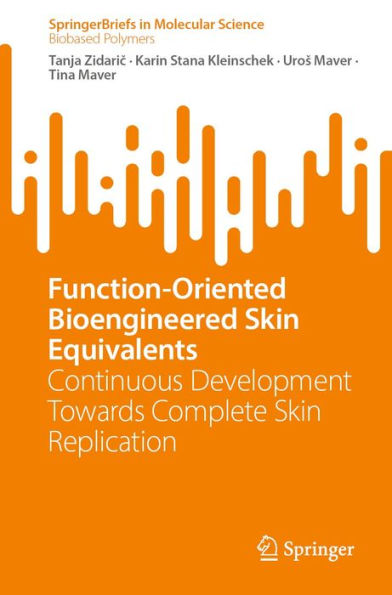Tanja Zidarič is a PhD researcher at the Institute of Biomedical Sciences at the Faculty of Medicine, University of Maribor (IBS MFUM), where she has acquired extensive knowledge in the field of tissue engineering, overlapping with materials science, biofabrication, cell biology, chemistry and microbiology. In addition, her research focuses on the development of electrochemical sensors designed for the detection of clinically relevant biomolecules. She is the project leader of her postdoctoral project in which a part was dedicated to the development of an in vitro skin model. Her bibliography consists of 27 units, including 11 scientific papers, 8 conference contributions, one elaborated and one patent.
Karin Stana Kleinschek† is a Professor at Faculty of Technical Chemistry, Chemical and Process Engineering, Biotechnology and a Head of Institute of Chemistry and Technology of Biobased Systems at Graz University of Technology(TU Graz), where she teaches various courses on polymers, surface properties of polymeric materials, biopolymers, biopolymers in medical application. From 2011 to 2015, she was a Vice Rector for Research and Development of the University of Maribor. From 2004 to 2016, she was the Head of the Institute of Engineering Materials and Design, Faculty of Mechanical Engineering, University of Maribor and is Head of the Laboratory for Characterization and Processing of Polymers (LCPP), which is a part of the institute. She is a member of various scientific organizations (as Member of the scientific committee of International Conferences of Polymer Characterization POLYCHAR, Member of the Electrokinetic Society scientific board, Member of the EPNOE-ACS Conference…). She is Vice President for Research of the European Polysaccharide Network of Excellence (EPNOE)—BIC Association. Since 2013 she is a Member of the European Academy for Science and Art and from 2014 Associate Member of Slovenian Academy of Engineering. In addition, she is a thesis supervisor at University of Maribor, University of Ljubljana, University of Nova Gorica, Slovenia and TU Graz and University of Graz, Austria. Her field of expertise is surface modification and characterization of polymeric materials with special attention on polysaccharides and its usability in biomedical applications (3D bioprinting and bioinks development, biopolymer composites and nanoparticles preparations). Her bibliography consists of more than than 1150 units, including 220 scientific peer-reviewed papers and book chapters, more than 50 lectures as a visiting speaker, as well as more than 500 contributions from scientific conferences, patents and innovations. Moreover, she implemented and coordinated more than 41 research projects/activities (2007-present), such as EU projects: (Horizon 2020, 7th FP, Era.NET, COST, EU, Structural funds), programmes and projects funded by ARRS, activities relating to the development and implementation of the Slovenia and EU higher education and research policy and more research activities funded directly by Slovenian and EU industries.
Uroš Maver†,‡ is a Head of IBS MFUM and an Associated Professor in the Department of Pharmacology at the Faculty of Medicine, University of Maribor (MFUM). His research interests include topics such as preclinical in vitro models, surface functionalization, drug delivery systems, tissue engineering and wound healing, and molecular-resolution microscopy, especially atomic force microscopy in life sciences. As part of his research, he also leads several joint projects with the University Clinical Centre Maribor (involving various departments, from plastics, dermatology, orthopaedics, and ophthalmology). His bibliography includes more than 396 units (including more than 122scientific papers, 11 invited lectures, 130 contributions to conference proceedings, more than 15 final reports on national andinternational projects, 17 elaborates, 2 patent and 2 patent applications) with a proven track record as a project leader and author of 12 publications recognised as outstanding achievement with the highest scientific merit in the last decade. In 2018, he was awarded the Outstanding Scientific Work Award by the University of Maribor. According to the national evaluation of the Slovenian Research Agency (ARRS), he was among the top 20 researchers in the field of biomedicine in recent years.
Tina Maver† The desire to improve patient lives led her into scientific waters. After graduating from the Faculty of Pharmacy University of Ljubljana (UL), she worked with the Trauma Clinic of University Medical Center Ljubljana, where she developed advanced wound dressings for wound care. During her PhD studies in Biomedicine (at the Faculty of Medicine, UL), she developed two prototype wound dressings containing immediate and long-term pain relief drugs. Afterwards, she was granted a postdoctoral project and expanded her skin pharmacology research with 3D printing technology. Combining the knowledge of skin pharmacology with biomedical engineering is also her future research direction. Her extensive expertise in the application of biofabrication techniques (3D bioprinting and electrospinning) is evidenced by her bibliography, which consists of 156 units, including 30 scientific papers, 4 chapters in a monograph, 1 monography, 6 invited lectures, 43 contributions to conference proceedings, 12 final reports on national and international projects, 12 elaborates, 1 patent and 1 patent application. She has led several projects in the past (postdoc, national project, clinical projects, PI of a partner institution in some projects) and is the author of 5 publications recognized as outstanding achievements by ARRS.



